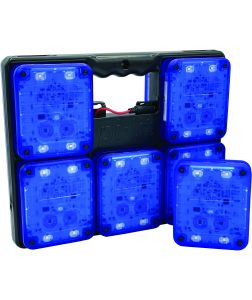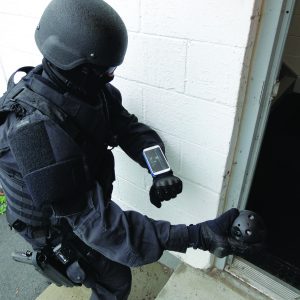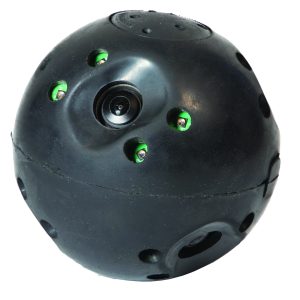Of their many duties, responding to emergencies can be some of the most intense for law enforcement. But it may be when the public is most in need.
From active shooters and traffic accidents to search and rescue, many things need to be considered while en route to what may be a life-or-death situation.
Fortunately, there are many products that officers can deploy to assist in these instances.
Getting to the Scene
Although first responders are the first to arrive, that does not mean that they have an easy time getting to the scene.
In 1968, a company was born out of 3M technology that was designed to allow emergency vehicles approaching an intersection to request that the impending traffic signal be preempted.
Headquartered in St. Paul, Minnesota, is Global Traffic Technologies, LLC (GTT)—a leader in traffic signal priority control. For more than 50 years, GTT’s Opticom traffic signal priority control solution has helped increase safety, minimize traffic congestion, and re-duce greenhouse gas emissions while maximizing resource efficiency and performance.
What began as line-of-sight, infrared technology has become a radio- and cloud-based, centralized solution that can be shared across various agencies in the city.
For decades, many fire and EMS first responders have benefitted from Opticom Emergency Vehicle Preemption (EVP), but, due to recent product innovations, law enforcement agencies are reaping the benefits as well. “Opticom has benefitted hundreds of law enforcement agencies,” said senior vice president Terry Griffith. “And with innovations such as incident-based preemption, we expect it to help countless more in the future.”
To improve the solution’s functionality for law enforcement, GTT has added features such as incident-based preemption. This allows preemption to be activated based on pre-determined incident types and priority levels by integrating Opticom EVP technology with the department’s computer-aided dispatch.
When officers respond to an emergency, they can request that the traffic lights be preempted upon approach to an intersection, so intersections are clear and the lights green. This helps to ensure faster, safer response for officers and the citizens they serve. According to company and U.S. Department of Transportation studies, this technology can help reduce intersection accident rates by up to 70 percent and improved response times by up to 25 percent.
GTT still encourages officers to drive with caution when approaching a traffic light, but, if a request is granted and certain parameters are met, the traffic light should be green for emergency vehicles.
Also striving to improve roadway safety during emergencies is Pi Variables, Inc. (pi-lit). Since 2013, the Orange County, California-based technology company has been developing, manufacturing, and supporting smart traffic control devices.

The pi-lit ICS Flare was designed to replace the flame flare and keep first responders on roadsides safe. Chief Executive Officer Jim Selevan explained that he based the original idea of the flare off a runway landing light. He wanted to create a less confusing work zone that would effectively move traffic away from the officer.
Rather than having the same issue as traditional flares, the pi-lit ICS Flares boast a rectangular design that keeps them from rolling off the road, and they run on batteries—not a fuse—eliminating fire danger. The flatter design also offers a longer battery life.

The flares are offered in a 6- or 10-set carrying case, which also doubles as a charging dock. Therefore, the lights can be taken directly from the case and placed on to the roadway without worry that they will light up. Due to pi-lit’s patented mesh network, the flares automatically sequence on the road in four different patterns—fast, slow, flash simultaneously, or steady burn. The officer can adjust the direction of the flash by simply tilting the light or by pressing a button.
The flare has successfully been tested to withstand 50,000 pounds and harsh weather conditions. Because of the versatility of the flare, some have even used them as a lightbar on the back of a vehicle.
Solutions for the Situation
Officers not only need assistance arriving safely to the emergency site, but they also need the proper tools to get bystanders and victims safely away.
This is where Bounce Imaging can help.

Now based out of Buffalo, New York, Bounce Imaging was originally founded at the Harvard Innovation Lab and the Massachusetts Institute of Technology. These tactical, throwable cameras can transmit 360-degree video instantly to any Android or iOS device.
The idea for the product first came to Bounce Imaging’s founder, Francisco Aguilar, when he was watching search-and-rescue efforts following the earthquake in Haiti. He saw first responders struggling to search through rubble for survivors even with high-tech equipment. It was his goal to create a relatively low-cost, ruggedized, tactical camera that could be used in tight spaces that may be too dangerous to enter.
To provide instant situational awareness, the camera has been used in a number of situations, including high-risk warrants, hostage incidents, and barricaded sub-jects. The camera can be mounted on a pole, thrown into rooms and confined spaces, lowered via tether, or attached to a mount on the vest of a K-9. The user will instantly receive video transmission and two-way audio.

Emergency Services Group International (ESGI) developed an innovative tool to aid law enforcement agencies during large-scale responses.
The Virginia-based company has developed an app that tracks witnesses, victims, and survivors of emergency situations. Fling Track allows for responders to immediately send data to a central, secure database; capture information on-site; and securely manage data for individual incidents.
The app can be used in response to large-scale incidents, such as an active shooter, or for mass arrests. Fling Track allows an agency, group, or organization to download a secure app to their smartphone to track individuals from the beginning of an incident through reunification. Without the use of bar-
codes or supplemental equipment, the app uses a photo of the individual’s face as a unique barcode-like tracking signifier along with other demographic information, such as name, age, contact information, and other pertinent information that can be customized to the response or agency.
In order to catalog witnesses, potential accomplices, arrestees, or others involved who may need to be questioned during the course of the investigation, the officer would take a picture of the individual with a smart phone and complete a customizable information form to “fling” to the secure database. The officer’s agency would then have access to a database of individuals, including photos and important notes, to easily follow up with a witness as the investigation continues.
To address privacy concerns, no information remains on the phone once it is collected.
“The problem of tracking is well documented and becomes an impediment when done poorly to what first responders do best, which is to protect the public and save lives,” said Jeff Dulin, a strategic advisor who has developed multiple innovative geospatial platforms. “This new commercial off-the-shelf (COTS) technology incorporating geospatial awareness is already proven effective by DHS, and it should be broadly implemented to finally solve this issue.” ESGI believes this thinking and technology can be applied across the homeland security enterprise, to include law enforcement and witness tracking and mass arrest scenarios at high-threat events, to add value for agencies at a low cost and to gain a tactical informational advantage.
ESGI can also work individually with law enforcement agencies to develop uniquely tailored high threat training to match their needs, culture, operations, and personnel requirements. For law enforcement, ESGI currently offers Tactical Emergency Casualty Care, Warm Zone Care, Nonconforming Emergency Response, and Atypical Response Team Development training.
Law enforcement officers are often the first to step up to help the general public in emergencies, putting their own lives at risk. Many companies, however, are in their corner, creating products to help the officers in these circumstances.d
|
SOURCE LIST Please click on the companies’ names to go to their websites or visit the Police Chief Buyers’ Guide to request information from companies. |
||
|
Emergency Services Group International
|
Global Traffic Technologies, LLC
|
RT LTA Systems, Ltd. Seahorse Protective Equipment Cases
|


